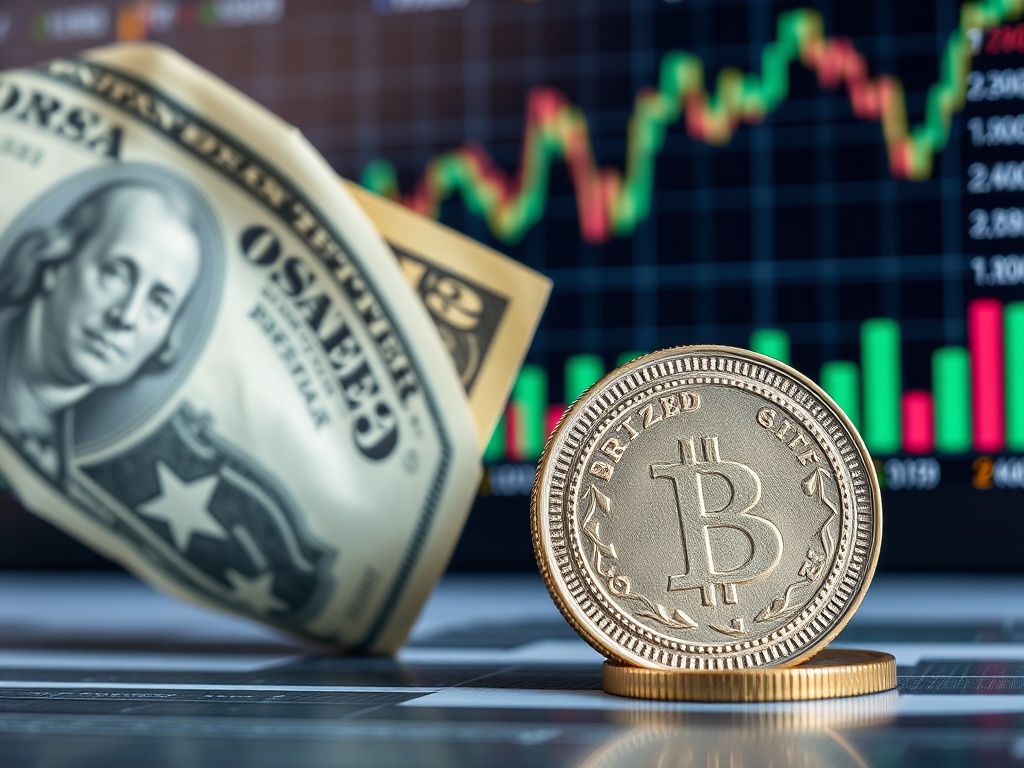BitcoinWorld

Dollar’s Crucial Uncertainty: Navigating US Inflation and Sterling’s Ascent
The global financial landscape is abuzz with anticipation as the United States gears up for a pivotal inflation data release. For cryptocurrency enthusiasts and traditional investors alike, the ripple effects of this announcement could be profound. The Dollar has recently experienced a slight dip, reflecting market jitters and strategic positioning ahead of what promises to be a defining moment for economic policy. Meanwhile, the British Sterling has shown surprising strength, adding another layer of intrigue to the unfolding currency drama. Understanding these movements is crucial for anyone navigating the interconnected world of finance.
Why is the Dollar on Edge? The Inflation Countdown Begins
The US Dollar, often considered the bedrock of global finance, finds itself in a precarious position. Its recent softening is largely a pre-emptive reaction by traders and investors bracing for the Consumer Price Index (CPI) report. This key inflation metric is more than just a number; it’s a critical barometer that influences the Federal Reserve’s monetary policy decisions, particularly regarding interest rates. When inflation is high, central banks typically consider raising interest rates to cool down the economy, which can strengthen the dollar by making dollar-denominated assets more attractive. Conversely, signs of easing inflation might prompt expectations of rate cuts, potentially weakening the currency.
Several factors contribute to the dollar’s current sensitivity:
- Market Speculation: Traders are positioning themselves based on their forecasts for the CPI data. A hotter-than-expected print could spark a dollar rally, while a cooler reading might trigger further declines.
- Federal Reserve’s Stance: The Fed has consistently reiterated its data-dependent approach. The upcoming inflation figures will heavily influence whether they maintain their hawkish stance, pivot towards easing, or adopt a wait-and-see approach.
- Global Economic Health: The dollar’s status as a safe-haven currency means its value is also influenced by global economic stability. Any signs of global slowdown or increased geopolitical tension can paradoxically strengthen the dollar as investors flock to safety.
Unpacking the Impact of US Inflation: What Do the Numbers Mean?
The upcoming US inflation report, specifically the CPI, provides a detailed look at the cost of goods and services. It’s a comprehensive measure that reflects the purchasing power of the dollar and directly impacts everyday consumers and large corporations. For investors, understanding the nuances of this report is paramount, as it dictates the future trajectory of monetary policy.
Here’s how different CPI outcomes could play out:
| CPI Outcome | Potential Dollar Reaction | Likely Fed Response | Broader Market Impact |
|---|---|---|---|
| Higher than Expected (Hot Inflation) | Dollar strengthens (initial reaction) | Increased likelihood of rate hikes or prolonged high rates | Bond yields rise, stock market volatility, potential pressure on risk assets like crypto |
| Lower than Expected (Cooling Inflation) | Dollar weakens | Increased likelihood of rate cuts or earlier cuts | Bond yields fall, potential stock market rally, positive for risk assets (crypto) due to cheaper borrowing |
| In Line with Expectations | Modest dollar movement, consolidation | Fed maintains current policy, reinforces data-dependent stance | Market largely priced in, less volatility, focus shifts to next data points |
The “core” CPI, which excludes volatile food and energy prices, is often scrutinized even more closely by central bankers as it provides a clearer picture of underlying inflationary trends. A persistent rise in core inflation would be a significant concern for the Fed.
The Rise of Sterling: A Glimmer of Hope Across the Pond?
While the dollar faces headwinds, the British Sterling (GBP) has been enjoying a period of relative strength. This surge isn’t merely a byproduct of dollar weakness; it reflects specific dynamics within the UK economy and the Bank of England’s (BoE) policy outlook. The BoE has maintained a relatively hawkish stance compared to some other major central banks, indicating a willingness to keep interest rates higher for longer to combat stubborn inflation in the UK.
Key drivers behind Sterling’s recent gains include:
- Stubborn UK Inflation: Unlike the US, where inflation has shown more consistent signs of cooling, UK inflation has proven more persistent, particularly in the services sector. This has prompted the BoE to signal continued vigilance.
- Higher Rate Expectations: Markets are pricing in a higher probability of the BoE maintaining or even raising rates further, making the pound more attractive for yield-seeking investors.
- Improved Economic Sentiment: Despite ongoing challenges, there have been pockets of positive economic data from the UK, contributing to a more optimistic outlook for the pound.
However, it’s important to note that the UK economy still faces significant structural challenges, and the sustainability of Sterling’s gains will depend on continued positive economic indicators and the BoE’s ability to navigate inflation without stifling growth.
Navigating the Volatile Forex Market: Strategies for Investors
The forex market, or foreign exchange market, is the largest and most liquid financial market in the world, with trillions of dollars exchanged daily. Its immense size means that even slight shifts in economic data or central bank rhetoric can trigger significant currency movements. For investors, especially those with exposure to international assets or cryptocurrencies, understanding forex dynamics is not just academic; it’s a necessity for managing risk and identifying opportunities.
Here are some actionable insights for navigating this volatility:
- Stay Informed: Keep a close eye on economic calendars, central bank announcements (Fed, BoE, ECB, etc.), and geopolitical developments. These are the primary drivers of currency movements.
- Diversify Your Portfolio: Don’t put all your eggs in one currency basket. Diversifying across different assets and even different currencies can help mitigate risk during periods of high volatility.
- Understand Correlations: Currencies often have inverse or direct correlations with other asset classes. For example, a strong dollar can sometimes put downward pressure on commodity prices and, at times, risk assets like cryptocurrencies.
- Risk Management: Implement stop-loss orders if you are actively trading forex. For long-term investors, consider hedging strategies if you have significant exposure to foreign currencies.
- Long-Term vs. Short-Term: Differentiate between short-term market noise and long-term trends. While daily news can cause fluctuations, fundamental economic strength and policy direction often dictate the broader trajectory of a currency.
The interconnectedness of the global financial system means that shifts in the dollar or sterling can indirectly influence the liquidity and sentiment within the cryptocurrency market. A stronger dollar, for instance, can sometimes make Bitcoin and other cryptocurrencies less attractive as investors seek safer, yield-bearing assets, though this correlation is not always consistent.
Beyond the Headlines: How Interest Rates Shape Currency Fortunes
At the heart of currency valuation lies the concept of interest rates. Central banks use interest rates as their primary tool to manage inflation and stimulate or cool economic activity. When a central bank raises its benchmark interest rate, it makes borrowing more expensive and saving more attractive. This tends to draw foreign capital into the country, as investors seek higher returns on their investments, thereby increasing demand for the local currency and strengthening it.
Conversely, when interest rates are lowered, it makes borrowing cheaper, which can stimulate economic growth but also makes the currency less attractive to foreign investors, potentially leading to depreciation. The “carry trade” strategy, where investors borrow in a low-interest-rate currency and invest in a high-interest-rate currency, is a prime example of how interest rate differentials drive currency flows.
The current global economic climate is characterized by central banks grappling with persistent inflation while trying to avoid recession. The differing paces and magnitudes of rate hikes (or potential cuts) among major central banks are creating significant divergences in currency performance. The Federal Reserve’s path for US rates, the Bank of England’s response to UK inflation, and the European Central Bank’s evolving policy all contribute to the complex tapestry of the forex market.
Understanding these underlying monetary policy frameworks is crucial for predicting currency movements beyond just the immediate reaction to economic data releases. It’s about recognizing the long game central banks are playing to achieve price stability and sustainable growth.
Challenges and Opportunities: The inherent unpredictability of economic data and geopolitical events remains a significant challenge. Unexpected inflation spikes or geopolitical tensions can quickly reverse market trends. However, these periods of volatility also present opportunities for informed investors who can anticipate and react to shifts. For instance, a clear dovish pivot by the Fed could signal a more favorable environment for risk assets, including cryptocurrencies, while a hawkish stance might suggest caution.
Actionable Insights for the Future: As we await the crucial US inflation figures, remember that the market is a dynamic entity. Don’t base decisions solely on single data points. Instead, look for trends, understand the broader economic narrative, and consider the implications for your overall investment strategy. The interplay between the dollar, inflation, sterling, and interest rates will continue to shape the global financial landscape, offering both challenges and compelling opportunities for those who stay vigilant and informed.
In conclusion, the slight dip in the Dollar ahead of the key US inflation release, juxtaposed with the gains of Sterling, highlights the delicate balance within the global forex market. The path of interest rates, guided by central bank responses to inflation, will ultimately dictate the trajectory of these major currencies. For investors, particularly those engaged with the volatile world of cryptocurrencies, monitoring these macro-economic indicators is not just prudent but essential for making informed decisions and navigating the ever-evolving financial currents.
To learn more about the latest Forex market trends, explore our article on key developments shaping US Dollar and interest rates liquidity.
This post Dollar’s Crucial Uncertainty: Navigating US Inflation and Sterling’s Ascent first appeared on BitcoinWorld and is written by Editorial Team





